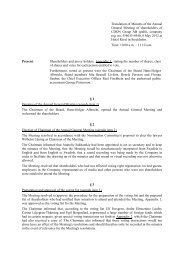Annual Report 2010 - CDON Group
Annual Report 2010 - CDON Group
Annual Report 2010 - CDON Group
Create successful ePaper yourself
Turn your PDF publications into a flip-book with our unique Google optimized e-Paper software.
<strong>CDON</strong> <strong>Group</strong> AB<br />
<strong>Annual</strong> Årsredovisning report <strong>2010</strong> <strong>2010</strong><br />
2.10 Financial instruments<br />
Financial instruments recognised on the statement of financial position include cash and cash equivalents, loan receivables, and<br />
accounts receivable among the assets and accounts payable and loans payable among the liabilities.<br />
2.10.1 Recognition on and derecognition from the statement of financial position<br />
A financial asset or financial liability is recognised on the statement of financial position when the company becomes a party to the<br />
contractual provisions of the instrument. Accounts receivable are entered on the statement of financial position when an invoice is<br />
sent. Liabilities are entered when the counterparty has rendered a service or supplied a product and there is a contractual<br />
obligation to pay, even if an invoice has not yet been received. Accounts payable are recognised when an invoice is received.<br />
Financial assets are removed from the statement of financial position when the entitlements of agreements are realised, fall due, or<br />
the Company loses control of them. The same applies to part of a financial asset. Financial liabilities are removed from the<br />
statement of financial position when contractual obligations are fulfilled or are otherwise extinguished. The same applies to part of<br />
a financial liability.<br />
Financial assets and financial liabilities are offset and recognised at the net amount on the statement of financial position only when<br />
there is a legal offset right for the amounts and the intention is to (1) settle the items at a net amount, or (2) realise the asset and<br />
settle the liability simultaneously.<br />
Acquisitions and disposals of financial assets are recognised on the settlement date, which is the date the asset is delivered to or<br />
from the Company.<br />
2.10.2. Classification and measurement<br />
Financial instruments that are not derivatives are initially recognised at cost corresponding to the fair value of the instrument, plus<br />
transaction costs for all financial instruments apart from those in the category of financial assets at fair value through profit or loss;<br />
these are recognised at fair value excluding transaction costs. A financial instrument is presented at initial recognition based in part<br />
on the purpose for which it is acquired. The classification determines how the financial instrument is valued after initial recognition,<br />
as described below.<br />
Cash and cash equivalents consist of cash.<br />
2.10.3 Loans receivable and accounts receivable<br />
Loans receivable and accounts receivable are non-derivative financial assets that have fixed or determinable payments and are not<br />
quoted on an active market. These assets are valued at amortised cost, which is determined on the basis of the effective rate as<br />
calculated at the time of acquisition. Accounts receivables are recognised at the amounts expected to be received, that is, less bad<br />
debts.<br />
2.10.4 Other financial liabilities<br />
This category contains loans and other financial liabilities, such as accounts payable. Liabilities are valued at amortised cost.<br />
Consolidated financial assets and liabilities are allocated to the categories described in Note 20 Financial Instruments and Risk<br />
Management. Recognition of financial income and expenses is also described in item 2.8 above.<br />
57




